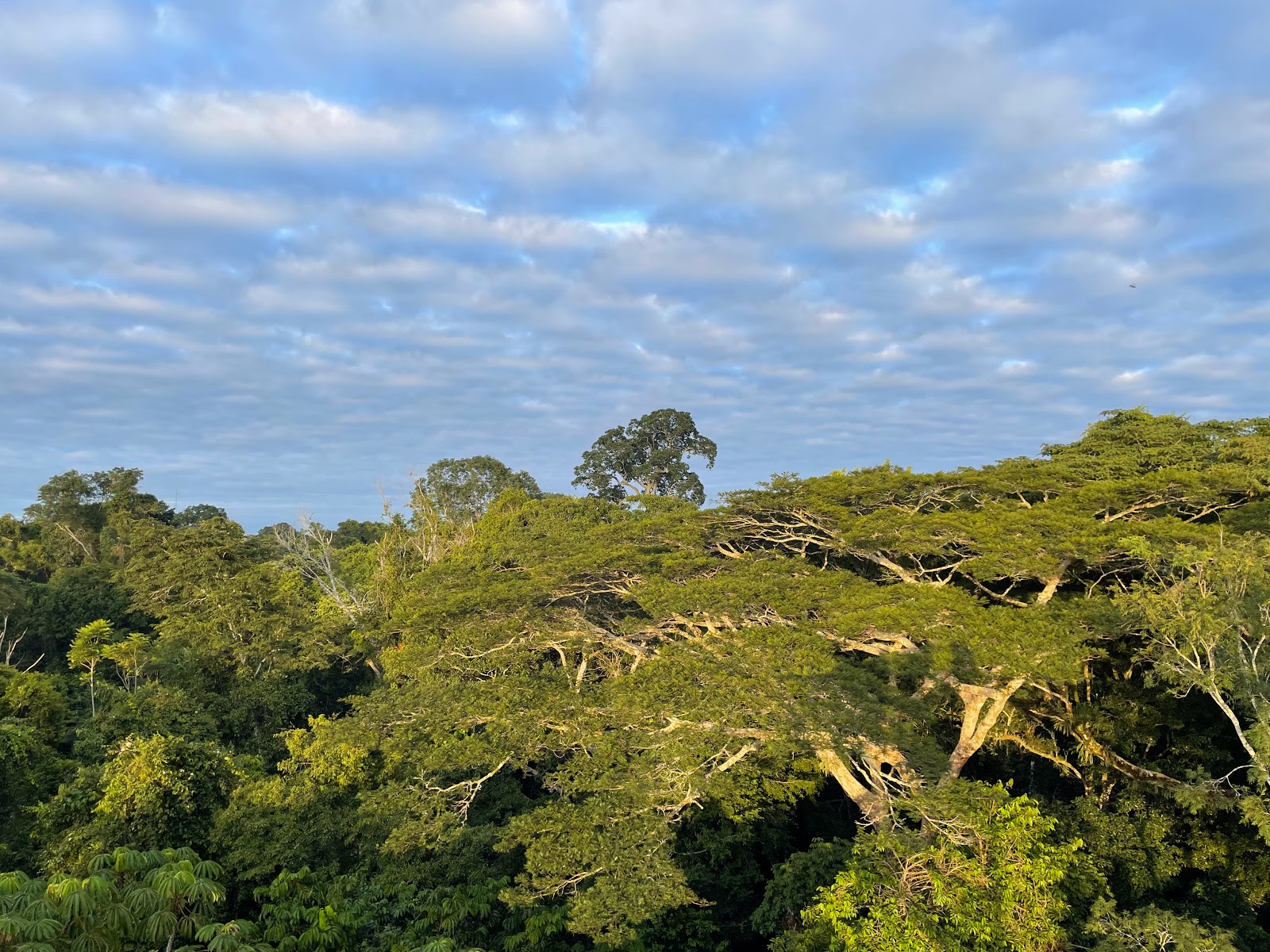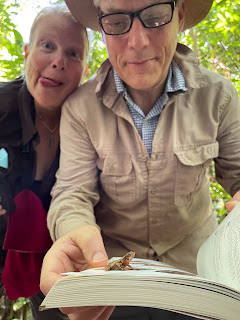Tambopata is famous for birds - more specifically, the macaws and parrots that come to the clay licks in search of minerals they need. But I was initially introduced to Tambopata by an entomologist, and my previous trip to the Amazon showed me how diverse (... and profuse!!) the insects are in the rainforest. And I never knew how interesting the flora could be, but exploring with a forest ecologist whose passion for every fern, orchid, and vine really made me appreciate the plant life - not to mention the mushrooms and molds that we encountered!! Being here is completely overwhelming... but exhilarating!
We were spending 9 days in Madre de Dios, and each day we had multiple forays into the rainforest. We were hiking 7-10 miles, usually on two or three outings each day, with some boat rides interspersed.
 |
| Stairmaster, schmairmaster |
On our first morning at Refugio, we woke up before dawn - our goal was to watch the sunrise from the 30-meter observation tower that would bring us up above the canopy of trees.
 |
From the tower we could see the top of the canopy, and the
emergent layer (the tops of the tallest trees) |
From the top platform, we had a stunning view of the endless sea of pristine forest, stretching for miles in every direction. Because we were above the overstory, it was much easier to spot the many species of birds that flock in the treetops.
 |
Clockwise, from top left: White-fronted nunbird, blue dacnis,
yellow-backed tanager, mealy parrot |
 |
| Just look at the gorgeous colors on these green and purple honeycreepers! |
 |
| WHEW, it's hot up there! |
Once the sun rose, it quickly got very, very hot so we made our way back down to the shade of the forest floor. One of the most sought-after sightings in the area is the Harpy eagle, one of the world's largest raptors - which can grow to be over three feet tall.
 |
| Searching for that Harpy |
A harpy eagle nest was located a few miles from the lodge, high up in an ironwood tree, so we went in search of this elusive bird.
 |
| Jillian, waiting patiently in the blind |
We spent about an hour at the blind and even went back in the afternoon, but the eagle didn't show itself. We did catch sight of the nest, though - so cool knowing that when the eagles finished it, it would be the size of a small room!!
 |
| The nest |
On another trip down to the river, we spotted this white (spectacled) caiman. The name 'spectacled' comes from the bony ridge between their eyes, that look like a pair of glasses. Caimans have more pointy snouts and longer, sharper teeth than their alligator cousins.
 |
| Here's hoping for a snack! |
 |
| Four different types of cacao! |
We crossed over to the other side of the river to visit a local farmer, who allowed us to try the various fruits that were planted on his property. The most interesting to me was the multiple varieties of cacao - the flesh is sweet and delicious, and I would never suspect that their seeds to be the hidden source for cocoa!
One morning, we took a trip to Lago Condenado, an oxbow lake (formed by the shifting waters of the river). Along the banks, we saw a small flock of hoatzin, with their distinctive blue faces and red eyes.
 |
It was hot on the lake, under the blazing
sun! Good thing we all had our 'hats'... |
 |
| Click to enlarge photo. See anything?? |
In one of our more intriguing sightings, Paul pointed to a dead log up ahead and told us all, "I see at least five mammals there!" We didn't see anything, then he upped his number. "Six. No, seven. At least ten." After our hint that this animal could fly, we figured out that they were bats - but we still couldn't find them.
It wasn't until we were parallel and could see their silhouettes that we finally discerned the upturned noses of these extremely camouflaged Long-nosed Proboscis bats.
 |
| Such great camouflage! |
After paddling across the lake, we took a short hike to see the 'biggest tree in the forest' - a strangler fig that had completely encompassed a large tree. It was so big that it no longer needed the support of the host tree, and had outcompeted it (possibly by stealing all of its sunshine and sapping it of nutrients).
 |
| At the buttresses of the kapok |
The inner tree had since decayed, leaving the strangler fig in a form that's known as a columnar tree, with a hollow core. It was so big we could all fit inside!
 |
Inside the columnar tree - bigger than
most NYC studio apartments! |
Near the strangler fig was a huge kapok tree, with lovely flying buttress roots. Kapoks are one of the tallest trees in the forest, which means they are vulnerable to gusts of wind up above the forest canopy. Because it has a shallow root system (which is common for rainforest trees because the fertile soil is at the surface), it forms the buttresses to help keep it from toppling over.
 |
Vegetarian piranhas!
(but clearly not gluten-free) |
On our way back across the lake, we stopped briefly to feed the piranhas. Did you know - piranhas eat bread?!
 |
| Lago Condenado |
We slowly hiked back to the lodge, enjoying the sights and sounds of the rainforest.
 |
The indigenous people call this the penis plant...
|
We saw dozens of these walking palms - an interesting plant because of its strange, spiky root system. In a wild fit of fantasy, (and particularly in the inky blackness of night), one can only imagine a sinister horde of these, skulking their way towards our poor innocent explorers...
So many interesting trees and vines!
 |
1. The naked tree sheds its bark every season in order to rid itself of any parasites.
2. Vines are fascinating! Some start from above and grow down, other start from the ground and grow up.
All are looking for support in their quest for sunshine... but might kill their host tree in the process.
3. I was particularly intrigued by the leaves of this creeping vine that had plastered itself flat onto the trunk of the tree. |
 |
| and this little frog who wanted to read about himself! |
And of course, we had lots of fun animal sightings...
 |
Like this curious saddleback tamarin...
|
 |
| This agouti visited the lodge |
 |
| He's hard to spot, but there's a red brocket deer eluding the paparazzi |
Our guides are adept at using all their senses to stay alert and observant. They have so much knowledge - not just in recognizing the plants, but in listening to sounds and identifying smells. As we walked back to the lodge from the oxbow lake, Paul suddenly stopped our group - he had smelled some fresh sloth pee! (now that's an impressive nose...)
Sloths spend all their time up in the treetops, but about once a week they will climb down to pee and poop, then climb back up a different (but nearby) tree. So we all craned our necks looking for the sloth. And finally, the other guide Angel spotted it! It was a two-toed sloth, sleeping in a palm tree. Just his back was visible, but he did stretch up his back leg to show off his sharp claws!
Staying at Refugio was a wonderful introduction to the rainforest - and we couldn't wait to move even deeper into its heart - to the only lodge inside the National Reserve, the Tambopata Research Center...































No comments:
Post a Comment